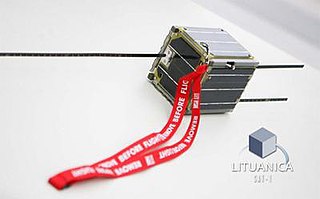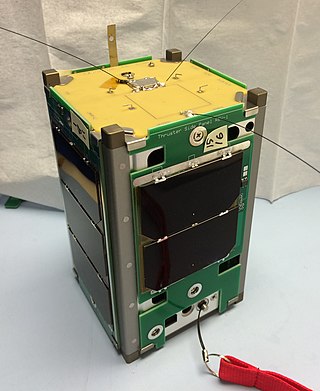| Mission type | Communications |
|---|---|
| Operator | U.S. Navy [1] |
| COSPAR ID | 2015-025D [1] |
| SATCAT no. | 40654 [1] |
| Spacecraft properties | |
| Bus | 1.5U Cubesat |
| Manufacturer | Aerospace Co. |
| Launch mass | 1.3 kilograms (2.9 lb) |
| Dimensions | 10 by 10 by 15 centimetres (3.9 in × 3.9 in × 5.9 in) |
| Start of mission | |
| Launch date | 20 May 2015, 15:05 UTC |
| Rocket | Atlas V 501 AV-054 |
| Launch site | Cape Canaveral SLC-41 |
| Orbital parameters | |
| Reference system | Geocentric |
| Regime | Low Earth |
| Semi-major axis | 6,822 kilometres (4,239 mi) [2] |
| Eccentricity | 0.160974 [2] |
| Perigee altitude | 341.5 kilometres (212.2 mi) [2] |
| Apogee altitude | 561.1 kilometres (348.7 mi) [2] |
| Inclination | 54.9919° [2] |
| Period | 93.5 minutes [2] |
| RAAN | 18.1944° [2] |
| Argument of perigee | 119.1910° [2] |
| Mean motion | 15.40667422 [2] |
| Epoch | 26 June 2018 [2] |
| Transponders | |
| Band | FM |
ParkinsonSAT, PSat or Naval Academy OSCAR 84 is a U.S. technology demonstration satellite and an amateur radio satellite for Packet Radio. It was built at the U.S. Naval Academy and was planned as a double satellite (ParkinsonSAT A and B). The name ParkinsonSAT was chosen in honor of Bradford Parkinson, the father of the GPS system. After successful launch, the satellite was assigned the OSCAR number 84.
The satellite was launched on May 20, 2015, with an Atlas V rocket along with the main payload X-37B OTV-4 and 9 other CubeSat satellites (X-37B OTV-4, GEARRS 2, LightSail A, OptiCube 1, OptiCube 2, OptiCube 3, USS Langley, AeroCube 8A, AeroCube 8B and BRICSat-P) from Cape Canaveral AFS, Florida.
ParkinsonSAT is a student satellite project. It was partly funded by the Aerospace Corporation. It has a transponder for transmitting telemetry from remote measuring points (eg drifting buoys). This telemetry is to be transmitted to a network of ground stations. A second transponder enables multi-user text transmission in PSK31 mode. This transponder was built by the Brno University of Technology. [3]
Originally, the project consisted of 2 identical satellites: PSat-A and PSat-B, 2 identical 1.5U Cubesats, which should be brought together in a 3U starter into space. During the long wait for a launch opportunity in 2014, the construction of the satellite was changed again. The solar cells have been replaced by new, more efficient cells. The other originally named PSat-B CubeSat was rebuilt and started as BRICSat-P.
AMSAT is a name for various amateur radio satellite organizations worldwide. In particular, it often refers to the Radio Amateur Satellite Corporation, headquartered in Washington, D.C. AMSAT organizations design, build, arrange launches for, and then operate (command) satellites carrying amateur radio payloads, including the OSCAR series of satellites. Other informally affiliated national organizations exist, such as AMSAT Germany (AMSAT-DL) and AMSAT Japan (JAMSAT).

AMSAT-OSCAR 51 or AO-51 is the in-orbit name designation of a now defunct LEO amateur radio satellite of the OSCAR series; formerly known as ECHO, built by AMSAT. It was launched on June 29, 2004 from Baikonur Cosmodrome, Kazakhstan on a Dnepr launch vehicle. It is in Sun synchronous low Earth orbit.
HAMSAT also known as HAMSAT INDIA, VU2SAT and VO-52 is a microsatellite weighing 42.5 kilograms (93.7 lb), providing amateur radio satellite communications services for Indian and international amateur radio operators. This satellite carries the in-orbit designation of VO-52, and is an OSCAR series satellite.
Brasilsat B1 is a Brazilian communications satellite launched on August 10, 1994, by an Ariane rocket model 44LP at Guiana Space Centre which is located in Kourou, French Guiana.
The United States Naval Academy (USNA) Small Satellite Program (SSP) was founded in 1999 to actively pursue flight opportunities for miniature satellites designed, constructed, tested, and commanded or controlled by Midshipmen. The Naval Academy's aerospace laboratory facilities are some of the most advanced and extensive in the country. These facilities include structures labs, propulsion and rotor labs, simulation labs, wind tunnels with flow velocities ranging from subsonic to supersonic, computer labs, and the Satellite Ground Station. The SSP provides funds for component purchase and construction, travel in support of testing and integration, coordination with The US Department of Defense or National Aeronautics and Space Administration (NASA) laboratories or with universities for collaborative projects, and guides Midshipmen through the Department of Defense (DoD) Space Experiments Review Board (SERB) flight selection process.
A communications satellite's transponder is the series of interconnected units that form a communications channel between the receiving and the transmitting antennas. It is mainly used in satellite communication to transfer the received signals.
SSETI Express was the first spacecraft to be designed and built by European students and was launched by the European Space Agency. SSETI Express is a small spacecraft, similar in size and shape to a washing machine. On board the student-built spacecraft were three CubeSat picosatellites, extremely small satellites weighing around one kg each. These were deployed one hour and forty minutes after launch. Twenty-one university groups, working from locations spread across Europe and with very different cultural backgrounds, worked together via the internet to jointly create the satellite. The expected lifetime of the mission was planned to be 2 months. SSETI Express encountered an unusually fast mission development: less than 18 months from kick-off in January 2004 to flight-readiness.

The Unified S-band (USB) system is a tracking and communication system developed for the Apollo program by NASA and the Jet Propulsion Laboratory (JPL). It operated in the S band portion of the microwave spectrum, unifying voice communications, television, telemetry, command, tracking and ranging into a single system to save size and weight and simplify operations. The USB ground network was managed by the Goddard Space Flight Center (GSFC). Commercial contractors included Collins Radio, Blaw-Knox, Motorola and Energy Systems.
AMSAT-OSCAR 16, also known as AO-16 and PACSAT, is the in-orbit name designation of an amateur radio satellite of the OSCAR series. It was built by AMSAT and was launched on 22 January 1990 from Kourou, French Guiana on an Ariane 4 launch vehicle. It is in Sun synchronous low Earth orbit.
An amateur radio satellite is an artificial satellite built and used by amateur radio operators. It forms part of the Amateur-satellite service. These satellites use amateur radio frequency allocations to facilitate communication between amateur radio stations.

LituanicaSAT-1 was one of the first two Lithuanian satellites. It was launched along with the second Cygnus spacecraft and 28 Flock-1 CubeSats aboard an Antares 120 carrier rocket flying from Pad 0B at the Mid-Atlantic Regional Spaceport on Wallops Island to the International Space Station. The launch was scheduled to occur in December 2013, but later was rescheduled to 9 January 2014 and occurred then. The satellite was broadcasting greetings of Lithuanian president, Mrs. Dalia Grybauskaitė. The satellite was deployed from the International Space Station via the NanoRacks CubeSat Deployer on February 28, 2014. All LituanicaSAT-1 subsystems have been turned on, tested and proved to be working properly. The mission is considered a complete success by its team of engineers. The mission ended upon the reentry and disintegration of the satellite on July 28, 2014.
iCube-1 is a miniaturised satellite built by the Institute of Space Technology in Pakistan, with an objective to provide a wide range of future experiments in the domain of imaging, microgravity, biology, nanotechnology, space dynamics, chemistry, space physics and various other fields. It can also provide a testbed for developing satellite constellations for specific applications.

FUNcube-1 is a complete educational single unit CubeSat satellite with the goal of enthusing and educating young people about radio, space, physics and electronics. It is part of a program which aims to launch more of these educational CubeSats. It is the first satellite with outreach as its primary mission.

Es'hail 2 is a Qatari satellite, launched aboard a SpaceX Falcon 9 rocket on November 15, 2018. Es'hail 2 was built by Japan's Mitsubishi Electric company, and operates at 26° East longitude along a geostationary orbit to provide direct-to-home television services in the Middle East and North Africa region. The satellite features 24 Ku-band and 11 Ka-band transponders to provide direct broadcasting services for television, government and commercial content distribution. In addition to commercial services, the payload of Es'hail 2 includes a linear transponder with a bandwidth of 500 kHz and 8 MHz for the amateur radio satellite service, with uplink on 2.4 GHz and downlink on 10.45 GHz.

PicoDragon is a small satellite that followed the 1U type of CubeSat program built by the Vietnam National Satellite Center (VNSC) which belongs to VAST and operated in space for 3 months.

The Iris transponder is a small, low power deep-space transponder designed by JPL for use in cubesats. It unifies a number of communication functions - receiver, command detector, telemetry modulator, exciters, and control functions - into one 1.2-kg package that occupies about 0.5 U. Iris is designed to handle X band uplink, UHF receive, and both X band and optional Ka band downlink. It is only one third the mass, and lower power, compared to the smallest previous solution, the Small Deep Space Transponder.
Fox-1D, AO-92 or AMSAT OSCAR 92 is an American amateur radio satellite. Fox-1D is a 1U CubeSat developed and built by AMSAT-NA. Fox-1D carries a single-channel transponder for mode U/V in FM. Fox-1D has an L-band converter, which allows the FM transponder to be switched on an uplink in the 23 centimetres (9.1 in) band.
BRICSat-P or OSCAR 83 (NO-83) previously known as PSat-B, is a U.S. technology demonstration satellite and an amateur radio satellite for Packet Radio. BRICSat-P is a low cost 1.5U CubeSat built by the U.S. Naval Academy Satellite Lab in collaboration with George Washington University, that will demonstrate on-orbit operation of a Micro-Cathode Arc Thruster (µCAT) electric propulsion system and carries an amateur communication payload.

BRICSat-2, or USNAP1, was an experimental amateur radio satellite from the United States Naval Academy that was developed in collaboration with George Washington University. BRICSat-2 was the successor to BRICSat-P. AMSAT North America's OSCAR number administrator assigned number 103 to this satellite; in the amateur radio community it was therefore called Navy-OSCAR 103, short NO-103.
PSAT-2 is an experimental amateur radio satellite from the U.S. Naval Academy, which was developed in collaboration with the Technical University of Brno in Brno, Czech Republic. AMSAT North America's OSCAR number administrator assigned number 104 to this satellite; in the amateur radio community it is therefore also called Navy-OSCAR 104, short NO-104.